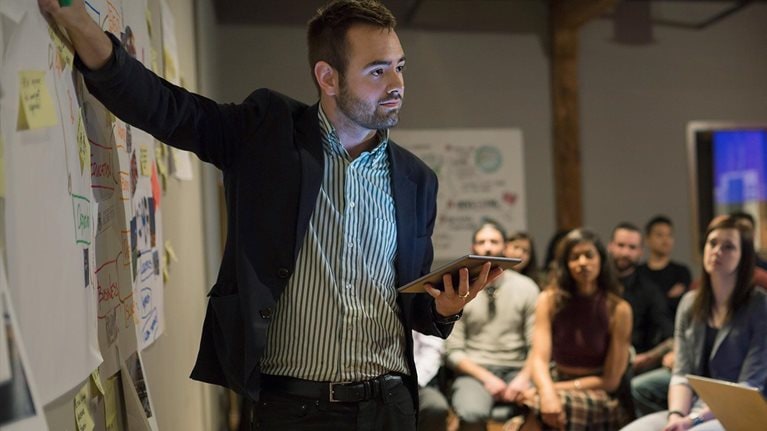The psychological contract that traditionally bound employees to their employers has been fraying. Many of today’s workers, having experienced the pain of the economic downturn and large-scale layoffs, no longer feel as much loyalty and commitment to their organizations as they did even a decade ago. Job hopping has been described as the “new normal,” and millennials are expected to hold 15 to 20 positions over the course of their working lives.1
Meanwhile, middle management—the executives who traditionally act as a conduit for communication from the top to the bottom of companies—has been hollowed out. So perhaps it’s no surprise that in the face of these two trends, leaders struggle to get their employees to embrace big change programs. Rather than adapt to the demands of an organizational transformation, employees are more likely to resist passively, undermining the effort and spreading that contagion throughout the organization. Or they might simply decide that such a transformation isn’t worth the risk and look for their next opportunity elsewhere.
To counter these problems, it’s more important than ever for companies in transition to invest time and effort in changing the mind-sets and behavior of the workforce. Almost 15 years ago, we introduced the idea that four key actions could work together to support such initiatives: fostering understanding and conviction, reinforcing change through formal mechanisms, developing talent and skills, and modeling the new roles. New research has since reinforced the significance of these four priorities. (For more on that research and the influence model it supports, see this article’s online companion, “The four building blocks of change.”)
The challenge for executives now is that they must learn to apply the model in new and imaginative ways that would not have been possible when we first published our research, at a time when the world was a very different place (exhibit). Back in 2003, the iPhone had yet to be released. There was no such thing as Facebook, much less Chatter, Twitter, or Yammer. The more fortunate millennials were off at college and still dreaming of the success they would eventually have from launching start-ups like Box or Instagram. Uber was just a German word. We rented movies at Blockbuster, drove around in Hummers, and read Newsweek—all of which have since folded.

Two key features of the modern workplace are particularly important in the context of change. One is the increasingly advanced technological and digital landscape, including mobile connectivity and social media, that has opened up exciting new possibilities for influence. The second is the new generation of millennial employees. On the surface, at least, they seem to have different needs and respond to change in ways that set them apart from their more tenured coworkers—though we’d echo our colleagues’ view (see “Millennials: Burden, blessing, or both?”) that their attitudes, in some ways, reflect those of the workforce as a whole. In the face of these interrelated opportunities and challenges, here are some ideas on how to win hearts and minds in the modern era.
New tools for influence
Digital advances can turbocharge efforts to foster understanding and conviction, thereby helping employees to feel more involved in change efforts and better able to play a role in shaping them. Consider, for example, how modern digital communications make it easy to personalize messages, tailoring them to the needs of individuals and delivering them directly to frontline employees. We take such personalized communications for granted, but they are significant in the context of major change efforts: they help to prevent a break in the cascade when a message trickles down from the CEO through middle management. For example, a global pharmaceutical company engaged in a major change program used its internal social-media platform in exactly this way, sharing different messages with different groups of users and ensuring that communications stayed relevant.
Technology also can help identify obstacles to change, such as overconfidence in your abilities or knowledge. Consider the popular FitBit and other activity trackers: these small devices provide an accurate (and sometimes surprising) picture of individual activity, expose the truth, and hold users accountable for their performance. Rapid-fire online-polling tools make it relatively straightforward to take an organization’s pulse, identifying differences in outlook and understanding between top management and the rank and file. Research based on McKinsey’s Organizational Health Index suggests that management frequently overestimates the impact of its messages on employees (for more, see “Why frontline workers are disengaged”).
Would you like to learn more about our People & Organizational Performance Practice?
More positively, leaders can use technology tools to celebrate skill building. For example, digital tools give organizations a creative way to show how increased effort (such as the adoption of new software or attendance at a training program) can improve performance. By profiling success stories on company Intranet pages and displaying training certificates and “badges” on Chatter and Yammer, organizations can instill a sense of control and competence that stimulates the improvement efforts of both individuals and teams.
Social platforms are more than just tools for communication and for building skills and a sense of community. They provide a sophisticated analysis that reinforces role modeling and builds up a momentum of influence. Over the past couple of years, we’ve seen a growing number of companies use social-networking analyses and similar techniques to help identify hidden influencers: people whose attitudes may command respect among their colleagues and whose role might be critical for the success of a change program. Having identified a few dozen influencers across regions, functions, and roles in this way, a large manufacturer we know enlisted the support of these employees to help communicate the changes it wanted to make, role-model the desired mind-sets and behavior, and fight skepticism.2
New employees, new challenges
Indeed, the power of the group may be the most potent influence of all. Today’s increasingly connected digital world provides more opportunities than ever to share information about how others think and behave. Millennials typically take their cue from positive reviews on Instagram, SnapChat, or Yelp or from “Twitterati” with many followers. It’s no surprise that users of social media can “buy followers,” thereby boosting the popularity of a person or brand when it starts trending. Millennial workers, sometimes described as “hyperconnected globally,” may be especially open to persuasion through the collective voice and expect real-time communication from everyone, not just top management.
The potential of technology to inspire action is good for would-be change agents, because today’s employees are increasingly skeptical. A generic change story won’t cut it now, if it ever did. To change hearts and minds, a story must be personally meaningful to the listener or reader. That’s particularly true for today’s younger employees. Recent interviews with hundreds of high-potential millennials, for example, revealed how, in many cases, their decisions to stay with or leave a company depended upon their ability to find meaning and purpose within it.
Technology’s new transparency, though, can be a double-edged sword. In today’s world, sites like Glassdoor take the mystery out of salaries and increased job mobility. That makes it easier than ever for employees to judge when they are unhappy with the direction of a company or decide that they are not getting an equitable deal. Remember, some twentysomethings recall how their own parents were mistreated in previous bouts of cost cutting, and many jaded older employees remain in the workforce. Organizations hoping to win over such employees need to do what’s necessary to neutralize compensation as a source of anxiety and focus instead on what really matters. For some workers, extra flexibility and telework may be more alluring than a bigger paycheck. Leaders directing significant change efforts should look at all the formal reinforcing mechanisms at their disposal.
Finally, don’t overlook skill building as a means of fostering commitment in the younger generation; millennials, after all, appear to be particularly hungry for opportunities to develop. The previously mentioned McKinsey research on this generation found many who were eager for advancement opportunities and receptive to various learning programs—from entrepreneurial challenges to more traditional rotational programs. In the past few years, organizations have started to tap into this mind-set, and some are exploring discounted education as an employee benefit. Starbucks’s college achievement plan, for example, now pays tuition fees for part- and full-time workers taking Arizona State University’s courses. Other organizations, such as Anthem and Fiat Chrysler Automobiles, have since launched similar programs.
Millennials may seem challenging. Yet their search—for diverse role models, meaning beyond a paycheck, equitable treatment in an increasingly transparent and transient world, and leading-edge skill building—is one that many employees, regardless of age, industry, or nationality, are undertaking today. Leaders who understand both the changing workforce and leading-edge digital tools and have a well-tuned grasp of the building blocks of organizational change should be well positioned to break through the noise and inspire these employees.


